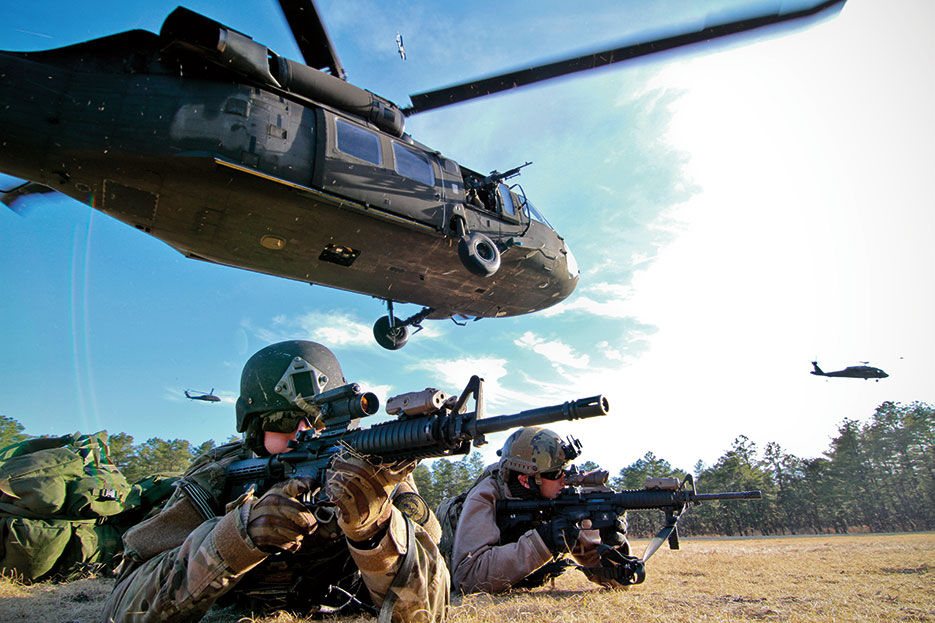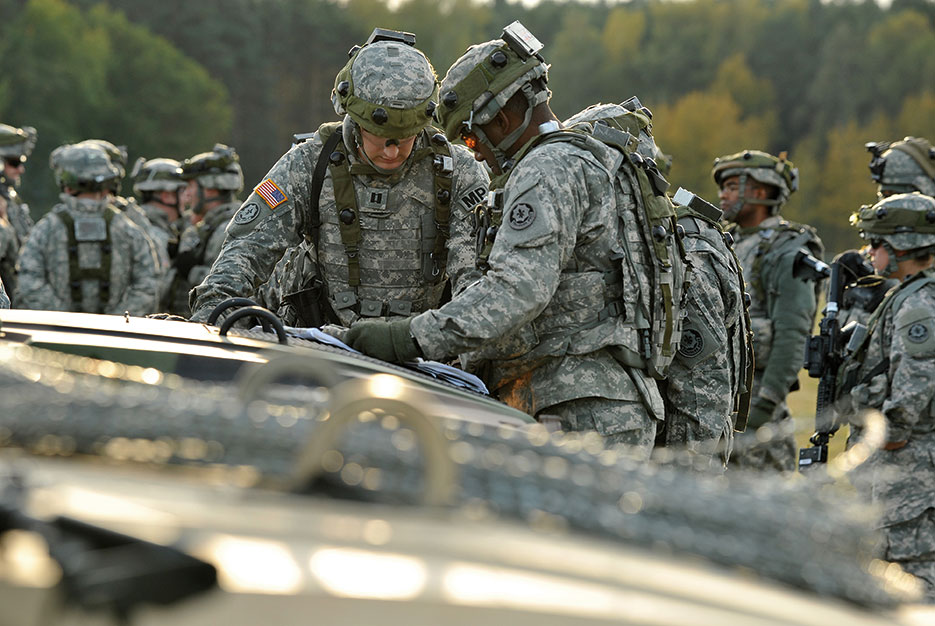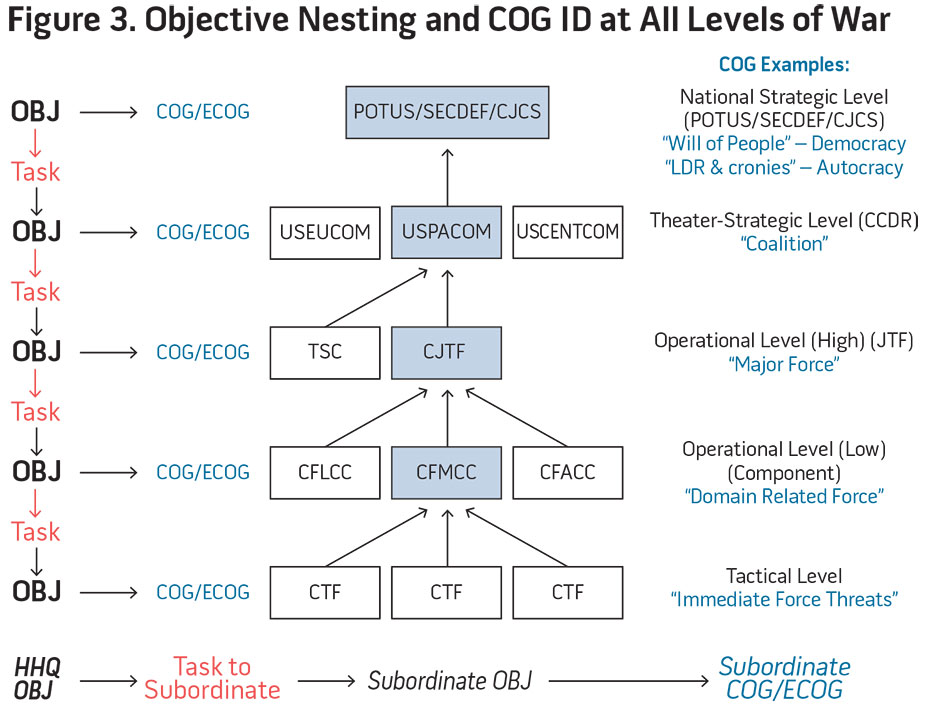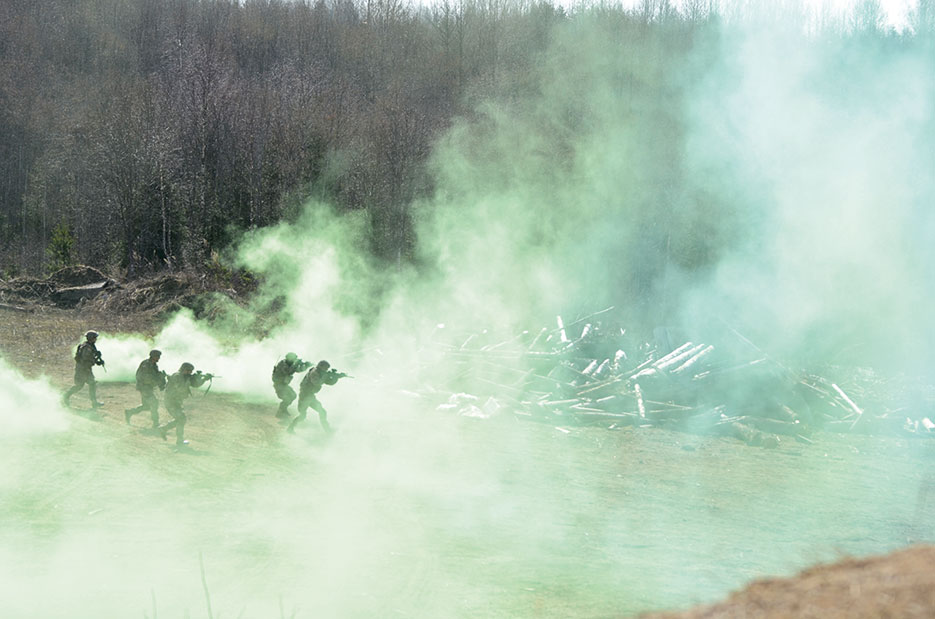DOWNLOAD PDF
Captain Steven D. Kornatz, USN (Ret.), is a Professor in the College of Operational and Strategic Leadership at the U.S. Naval War College.
Center of gravity (COG) continues to be a popular topic in military journals, blogs, and lectures. Many recent discussions have tended to be ambivalent at best toward the value of the concept of COG. Several of these dialogues present detailed contrarian views to the validity of Carl von Clausewitz’s much analyzed theory of COG (or Schwerpunkt, as presented in On War). They discuss how this theory is too complex to be used by U.S. military planners. However, the painstaking discussion of Clausewitz is done at the expense of missing the fact that the refined, modern-day view of COG is a critical concept for planners to understand and apply. When done correctly, COG planning methodology is the primary practical way to link an objective to a course of action (COA). This is not to assert that proper employment of COG methodology is always easy. Application in certain scenarios may be complex, but the important aspect of COG methodology is that when properly employed, it is the foundation of and gives direction to COA development.

Servicemembers provide cover after tactical air insertion with Army UH-60 Black Hawk helicopter at Fort Dix, New Jersey, April 10, 2014 (U.S. Air National Guard/Matt Hecht)
Root of the Problem
Some planners and many senior staff officers lack detailed knowledge of and confidence in the value and practical use of COG methodology. This comes primarily from three factors: overreliance on Clausewitz’s COG theory, differing doctrinal definitions of COG-related terms, and varying joint and Service doctrinal COG methodologies.
Present-Day Relevance of COG. Clausewitz’s theory is touted as the foundation for the U.S. military’s application of COG in current planning doctrine. While Clausewitz’s theory may provide some foundational legitimacy to the concept, it has little value in establishing detailed practical application of COG for planners, particularly at the operational level of war. For the many reasons recently presented by Dale Eikmeier, military planners need to be much less concerned with Clausewitz’s history and theory of COG than with the more critical value and application of contemporary COG methodology.1 In other words, while the theory of COG is sound, it does not answer modern-day methodology questions.
Differing Definitions. Joint Publication (JP) 5-0, Joint Operation Planning, defines center of gravity as a “source of power that provides moral or physical strength, freedom of action, or will to act.”2 It was only a short time ago that each Service had its own definition of COG. While it is significant that Service and joint COG definitions now align, the definition itself is too generic to be of value to planners.
Modern-day COG theorists have their own variations on the definition, which obviously had some influence on the current joint definition. Joe Strange proposed defining COG as “primary sources of moral or physical strength, power and resistance.”3 Milan Vego defined COG as:
a source of massed strength—physical or moral—or a source of leverage, whose degradation, dislocation, neutralization, or destruction would have the most decisive impact on the enemy’s or one’s own ability to accomplish a given military objective; tactical, operational, and strategic centers of gravity are differentiated; each center of gravity is related to the corresponding military objective to be accomplished.4
While both of these definitions use language similar to the current joint definition, Vego’s in particular presents three components that are critical to practical application by planners. His statement that “destruction would have the most decisive impact on the enemy’s or one’s own ability to accomplish a given military objective” ties COG directly to the objective and also specifies that a COG exists for both the enemy and oneself. In arguing that “tactical, operational, and strategic centers of gravity are differentiated; each center of gravity is related to the corresponding military objective to be accomplished,” Vego clarifies that COGs exist at each level of war and are tied to specific objectives tasked to each level of war.
COG analysis methodology in Navy Warfare Publication (NWP) 5-01, Navy Planning, combines the aspect of Vego’s writings that indicates how to identify a COG with Strange’s writings on how to attack/defend it. However, Navy doctrine uses some of the same terms as joint doctrine but defines them differently. Critical factors are defined as critical strengths (CSs) and critical weaknesses (CWs) in NWP 5-01, but are comprised of critical capabilities (CCs), critical requirements (CRs), and critical vulnerabilities (CVs) in JP 5-0.
Varying Methodologies. Various methodologies exist in doctrine that attempt to describe the practical application of the COG concept for use by planners. These methodologies mostly rely on Strange’s writings to determine how to attack (or defend) a COG. The identification of a COG, however, is glossed over in most doctrine (NWP 5-01 is an exception).5 Some doctrinal methodologies tend to take a critical concept and make it overly complex. Examples include JP 2-01.3, Joint Intelligence Preparation of the Operational Environment, which describes a COG as originating in a nodal system where it “typically will not be a single node in the system, but will consist of a set of nodes and their respective links”6 with no explanation as to how to identify the system, and Air Force Doctrine Document 3-0, Operations and Planning, which recommends synthesizing four different methodologies to identify and analyze COGs.7

U.S. Soldiers with 2nd Cavalry Regiment study map in preparation for convoy through area near Amberg, Germany, en route to U.S. Army Europe Joint Multinational Readiness Center’s Hohenfels Training Area in Germany, October 16, 2012, during Saber Junction 2012 (DOD/Markus Rauchenberger)
Practical Application
Practical application requires a practical definition of COG. The current doctrinal definition is rather ambiguous. Based on the military application of COG analysis, a simpler, reasonable definition follows: COG is the principal force/entity that accomplishes the objective at a specified level of war.
No matter which COG methodology is employed, planners cannot rely on a checklist mentality to implement COG in their work; they must have an internalized understanding of why COG is important to their efforts and confidence in a clear methodology to conduct its identification and analysis. Understanding the usefulness of COG comes from appreciating that its identification is a process that determines what (a force or entity) accomplishes a stated objective. The “thing” that accomplishes the objective is critical to planners because it must be dealt with, directly or indirectly, to preclude an adversary from accomplishing its objective. Likewise, the thing that accomplishes our friendly objective must be given a priority of effort, be sustained, and be protected for us to be successful.
Vego’s writings provide a credible method to identify a COG by determining CSs and CWs that are essential to accomplishing the objective.8 The COG is identified as the CS that actually accomplishes the stated objective. After listing the critical strengths, planners can analytically go down the list one by one and ask, “Does this critical strength accomplish the objective?” If the answer is “yes,” then it is a COG. If the answer is “no,” then it is probably a critical capability or critical requirement and possibly a critical vulnerability. The complexity arises in identifying critical strengths. Planners must ensure they are as detailed as possible in listing CSs to be as discrete as possible in the identification of a COG. This is essential, particularly at the operational level of war and the component (domain-related) level where a COG will typically be a specific force. For example, if Combined Force Maritime Component Commander (CFMCC) planners are working to identify a friendly COG in the maritime domain where an objective is seizure of an island, some critical strengths may be identified as ships, mines, and integrated air defense systems. The term ships, however, may be too general. Based on CFMCC maritime objectives, the landing force (amphibious ships and Marines) may be what explicitly accomplishes the objective, and the remainder of the surface ships (aircraft carriers, destroyers, supply ships, patrol vessels, and so forth) are merely in support. Knowing the value of detail in determining critical strengths and critical weaknesses to the COG process will yield more discrete and effective COG identification. This will allow for more focused analysis and clarity in COA development. The determination of both CSs and CWs is crucial not only because it narrows down the list of potential COGs (COG comes from a list of CSs), but also because the list of CWs will support determination of CVs later in the methodology.
Once the COG is identified, the CC/CR/CV method of analysis presented by Strange comes into play. This part of the methodology is how planners take an identified COG and ascertain the things that are critical to attack (or defend), which are clearly linked to undermining the COG. This becomes the foundation of the COAs. To be valid, each proposed COA must neutralize (defeat, destroy, and so forth) the enemy’s identified COG and must protect and support the identified friendly COG. Further COG analysis, to the level of CVs, provides details of susceptible aspects of critical requirements that can undermine a COG. With this understanding, COA development ensues, with planners employing innovation to propose different ways (the how) to neutralize the enemy COG while defending the friendly COG. This is the reason for the primacy of COG to planning: it links an objective to CVs that provide the foundation for the COAs (see figure 1).

NWP 5-01 does an effective job of describing the CC/CR/CV COG analysis methodology, but it is too vague in stating, “Many of these elements (CCs) are often found in the joint functions.”9 Planners must go to the six joint (or operational) functions (command and control, intelligence, sustainment, movement and maneuver, fires, protection) to begin their COG CC analysis. Common problems in resolving the CCs arise from two challenges. First, planners forget the necessary linkage that must be maintained from objective to COG to CC. For each identified CC, the linkage question, “Does this CC enable the COG to accomplish the objective?” must be asked. Without this linkage, the value of the process will break down. Second, planners often simply list the six joint functions as the CCs and move on. This also undermines the value of the process. In our example, if the landing force is identified as the friendly COG that seizes an island (objective), just stating “operational sustainment” as a CC is too general—this means everything is a priority for sustainment. A more refined CC associated with operational protection may be to “sustain the combat force ashore.” This provides a more discrete view of priorities for sustainment in the COA. Additionally, there often are multiple CCs associated with a joint function.
Similarly, a linkage must be maintained from CCs to CRs, which are the resources that allow the CC to enable the COG to accomplish the objective. In the above example, logistics ships, ship-to-shore connectors, ammunition, and food are resources that allow the CC (sustain combat force ashore) to enable the COG (landing force) to accomplish the objective (seize the island). This analytic linkage must be maintained for COG analysis to be useful.
The analysis continues further with determination of CVs. They are not CRs; they are “an aspect of a critical requirement which is deficient or vulnerable to direct or indirect attack that will create decisive or significant effects.”10 For the friendly COG, CVs are aspects of CRs that must be protected or mitigated. For the enemy, CVs are aspects of CRs that will provide for indirect attack of the enemy COG. In our example, a CV may be the susceptibility of logistics ships to submarine attack during transit. The CV is not the logistics ships; it is their vulnerability to submarine attack. The planners must determine how to mitigate that vulnerability in COA development to protect the ability of the COG to accomplish the objective. Otherwise, the commander will assume tremendous risk to mission success (see figure 2).
Is COG Analysis Too Difficult?
Some recent articles propose doing away with or dramatically altering COG analysis in planning. Lawrence Freedman suggests that instead of analyzing COGs, planners should answer the question, “What is the position you wish to reach?”11 Jeff Becker and Todd Zwolensky expound upon Freedman’s writings and recommend replacing COG with “joint maneuver.”12 While intriguing, neither of these assertions provides a practical methodology for planners to link COAs to an objective. Freedman’s “position you wish to reach” sounds like just another way of stating an objective. Likewise, to be useful, Becker and Zwolensky’s corollary to Freedman must identify what “joint maneuver” will be used against. In all likelihood, it will be a COG.
Dale Eikmeier and, more recently, Jan Rueschhoff and Jonathan Dunne proposed determining CCs first and then working backward to identify the COG because COG identification is difficult to do.13 In practical application, how can one identify CCs that enable a COG to accomplish an objective without first identifying the COG that actually accomplishes the objective? Certainly, the objective-COG-CC-CR-CV-COA linkages allow for a verifying “backward look” after the analysis has been completed. However, trying to identify a COG after determining CCs weakens the value of the linkage-based requirements of the COG analysis components.
On a practical level, planners must be able to rationalize and recommend to the commander the best employment of resources that will allow us to accomplish our objectives while precluding the enemy from accomplishing theirs. The important fact to remember is that COG analysis is a component of planning that focuses the efforts of planners. It is not an elusive “search for the knockout blow,” but simply a planning tool (albeit a complex one at times) that underpins a COA. How else can planners determine and prioritize what to attack and defend? Additionally, the COA must be assessed in execution to verify that the COG linkages determined in planning are in fact proving successful. Taking the COG linkages into execution, we have a cyclical pattern: determine objectives, identify COG, plan to attack/defend COG, execute the plan, assess the plan, and adapt the plan (by revisiting objectives and so forth). Without COG analysis, planners will be taking a shot in the dark at what to attack/defend.
Another potentially confusing point is that the friendly COG does not necessarily attack the enemy COG directly. Friendly and enemy COGs must be analyzed separately in planning since they are based on specific friendly and enemy objectives. When possible, planners should be innovative in COA development in using non-COG (friendly) resources to degrade or defeat the enemy COG, allowing the friendly COG to focus on accomplishing the friendly objective. For example, using friendly airpower to degrade enemy infantry forces (enemy COG) that are defending an island (enemy objective) will enable the friendly landing force (COG) to more readily seize the island (objective). Independent COG analysis by the J2 (for the enemy) and planning team (for the friendly) will keep friendly and enemy COGs from being intermixed, allowing more innovation in COA development.
COGs at each level of war are based on tasks from higher headquarters that become subordinate objectives (see figure 3). Objectives at one level necessitate tasks to subordinates. These tasks become objectives to that subordinate level, necessitating determination of a COG that accomplishes the nested subordinate objective. Complexity arises at the higher levels of war when the COG may not be a military force.

Vego states, “The true value of center of gravity may be the framework the concept provides for thinking about war. In other words, the process of determining centers of gravity may be as important as the product.”14 This underpins the idea that COG analysis is for planning. It gives planners something on which to focus the use of resources. In execution, however, staffs must use assessment to determine if the plan (based on COG analysis) is trending toward accomplishing the objective. If not, the COG analysis may be in error (that is, the CVs may not be as clearly linked to the COG and objective as planners originally thought), and a branch plan may need to be implemented.
All doctrine agrees that a COG is related to an objective. Objectives exist at each level of war, and objectives are accomplished by a COG. Joint and Service doctrine COG methodologies should be much more similar than they are currently. The methodology must have two parts: identification (what accomplishes an objective) and analysis (how to attack/defend it). Strange’s analysis methodology (CC, CR, and CV) is common within Service and joint doctrine and logical. The problem that arises is what may be the most important aspect of COG methodology: identification of a COG. This is where Vego’s methodology is particularly valuable. Just because COG analysis is difficult to do well does not mean it should not be used. It is the practical way to tie an objective to a COA.

U.S. Soldiers with 3rd Squadron, 2nd Cavalry Regiment, approach objective during squadron-level field training exercise at Tapa Training Area, Estonia, April 6, 2016 (U.S. Army/Steven M. Colvin)
What Really Matters
The following are COG-related ideas that are critical for planners (from planning team members to commanders) to know and believe:
- A COG is based on and linked to an objective; indeed, it is what accomplishes an objective.
- COG identification and analysis provide the foundation for COA development.
- COG is a planning concept; objectives or capabilities may change in execution, necessitating re-analysis of COGs.
- A great part of the value of COG analysis to planners are the discussion and debate that arise from conducting the analysis.
- Because they are based on objectives, COGs exist at each level of war and in each domain; this necessitates COG analysis by all joint task force components.
- Identification and analysis of COGs must be done as discretely as possible for focus and clarity in COA development.
- Do not assume that the friendly COG will be used to defeat the enemy COG; this may be an inefficient use of resources.
- Multiple varying objectives may necessitate multiple COGs.
- To limit confusion, planners should use level-of-war modifiers when discussing and briefing COG (for example, combatant commander COG, theater-strategic COG, joint task force COG, operational COG, maritime COG, and so forth).
- When planners truly understand COG, the concept and methodology are valuable and usable across the range of military operations.
COG identification and analysis are critical aspects of planning that enable planners and decisionmakers to have clarity in linking objectives to COAs. Without detailed use of the COG concept, planners may propose COAs that are not directly linked to the stated objective. COG methodologies must be understood deeply to ensure COG is given appropriate consideration throughout the planning process. JFQ

Australian Army Lieutenant and Gunner from 8/12 Regiment coordinate fire support as U.S. Marine from 2nd Battalion, 7th Marine Regiment looks on during Combined Joint Live Fire Exercise on Townshend Island during Talisman Sabre 2011 (Australian Army/Janine Fabre)
Notes
1 Dale C. Eikmeier, “Give Carl von Clausewitz and the Center of Gravity a Divorce,” Small Wars Journal, July 2, 2013, available at <smallwarsjournal.com/jrnl/art/after-the-divorce-clausewitz-and-the-center-of-gravity>.
2 Joint Publication (JP) 5-0, Joint Operation Planning (Washington, DC: The Joint Staff, August 11, 2011), xxi.
3 Joe Strange, “Centers of Gravity and Critical Vulnerabilities: Building on the Clausewitzian Foundation So We Can All Speak the Same Language,” Perspectives on Warfighting no. 4, 2nd ed. (Quantico, VA: Marine Corps University, 1996), 43.
4 Milan Vego, Joint Operational Warfare: Theory and Practice (Newport, RI: U.S. Naval War College, 2009), VII-13.
5 Navy Warfare Publication (NWP) 5-01, Navy Planning (Washington, DC: Headquarters Department of the Navy, December 2013), appendix C.
6 JP 2-01.3, Joint Intelligence Preparation of the Operational Environment (Washington, DC: The Joint Staff, May 21, 2014), IV-11.
7 Air Force Doctrine Document 3-0, Operations and Planning (Washington, DC: Headquarters Department of the Air Force, November 9, 2012), 111–117.
8 Vego, VII-15–VII-24.
9 NWP 5-01, C-3.
10 JP 5-0, GL-8.
11 Lawrence Freedman, “Stop Looking for the Center of Gravity,” War on the Rocks, June 24, 2014, available at <http://warontherocks.com/2014/06/stop-looking-for-the-center-of-gravity/>.
12 Jeff Becker and Todd Zwolensky, “Go Ahead, Forget Center of Gravity,” War on the Rocks, July 9, 2014, available at <http://warontherocks.com/2014/07/go-ahead-forget-center-of-gravity/>.
13 Dale C. Eikmeier, “A Logical Method for Center-of-Gravity Analysis,” Military Review (September–October 2007), 62–66; Jan L. Rueschhoff and Jonathan P. Dunne, “Centers of Gravity from the ‘Inside Out,’” Joint Force Quarterly 60 (1st Quarter 2011), 120–125.
14 Vego, VII-14.